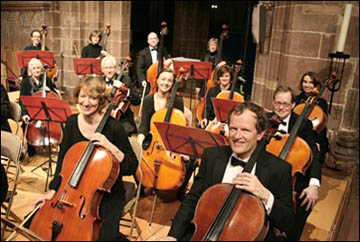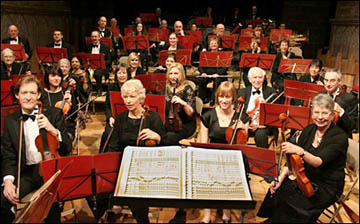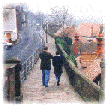
 hester was a centre of musical excellence in the late 18th Century. The focal point was the Cathedral and the Festivals, which commenced in 1772 with performances of Messiah, Samson and Judas Maccabeus. This entirely Handelian event was wholly appropriate. Had not the great man passed through Chester en route to Ireland in 1741, the year of the composition of The Messiah? hester was a centre of musical excellence in the late 18th Century. The focal point was the Cathedral and the Festivals, which commenced in 1772 with performances of Messiah, Samson and Judas Maccabeus. This entirely Handelian event was wholly appropriate. Had not the great man passed through Chester en route to Ireland in 1741, the year of the composition of The Messiah?
Years later, Dr Burney recollected seeing Handel 'smoking a pipe over a dish of coffee in the Exchange Coffee House'!
(the 17th century Exchange
was Chester's former Town Hall and Civic Centre that long stood in the centre of the Market Square before burning down in 1862).
Contemporary records suggest that these Festivals were well supported. It was the age of oratorio and this form seemed appropriate for the musical needs of the day.
The Festivals came to an end in 1829. The reasons for this lay, not only in the mediocrity of performance as noted by contemporary critics but also in the irreverent conduct of the artisans whose job it was to build the necessary staging within the Cathedral. These Festivals disappeared from the Chester scene for the next 50 years. This is not to say that there was no music making, but there was no central focus of endeavour and the several societies went their various ways.
It was against this background that two quite remarkable men came to the rescue, Joseph C Bridge, lately appointed Organist at the Cathedral, and Dean Howson. Their combined faith, purpose, drive, and initiative, made possible not only the recreation of the Festivals against overwhelming odds, but also the creation of the Chester Orchestral Society later to be known as The Chester Philharmonic Orchestra. The Festivals, still 'oratorio-based', were perhaps popular with the man in the street, but it is on record that the Bishop of Chester (Dr Jacobson) did not favour the Festivals, and William Ewart Gladstone (three of whose four terms lay before him) would not even allow his name to appear among the patrons as he wished it to be understood that he "decidedly disapproved of the performance of oratorio in Cathedrals or Churches".
 In late 1883, Bridge, tiring of the lack of unity in the musical societies, set about rectifying this by organising a major performance of Messiah in the Music Hall. Originally built around 1280 by the monks of the neighbouring Abbey (now the Cathedral) as a chapel dedicated to St Nicholas, those who have seen the Music Hall progress from cinema to supermarket to gentleman's outfitters and now a branch of Superdrug may not appreciate that it opened in 1855 as a concert hall with a Gothic front added by local architect James Harrison, and that in this capacity it housed not only musical but also dramatic productions. It could accommodate 1400 people with ample room for an orchestra and choir of 250 persons, and we know that no fewer than 1049 people attended the December 1883 performance of Messiah. In late 1883, Bridge, tiring of the lack of unity in the musical societies, set about rectifying this by organising a major performance of Messiah in the Music Hall. Originally built around 1280 by the monks of the neighbouring Abbey (now the Cathedral) as a chapel dedicated to St Nicholas, those who have seen the Music Hall progress from cinema to supermarket to gentleman's outfitters and now a branch of Superdrug may not appreciate that it opened in 1855 as a concert hall with a Gothic front added by local architect James Harrison, and that in this capacity it housed not only musical but also dramatic productions. It could accommodate 1400 people with ample room for an orchestra and choir of 250 persons, and we know that no fewer than 1049 people attended the December 1883 performance of Messiah.
"This advert for the Music Hall is interesting. I note that you have a Signor Piatti billed along with Signor Sivori. If these were Carlo Piatti and Camilo Sivori that must have been one hell of a concert. Sivori was a student of Paganini and gave the first performance in Britain of Mendelssohn's violin concero. Piatti was equally famous. If Chester really had these famous people playing there, note the 'understatement' of the advert..... but the cost of the tickets... Hells Bells!! T M"
Bridge invited all societies to take part and expressed the hope that "the formation of a Musical Society of a larger and more comprehensive nature might now be feasible". It was not to be however, since despite the success of the performance the various conductors still preferred to go their own way. This might have demolished a man of less stature than Bridge but, resilient and determined, he decided with strong support to "start a Society independent of all existing ones" with a choir and an orchestra. The 1883 Messiah orchestra was 49 strong and included no fewer than 6 clergymen which may show the special influence of Bridge. The organist was the Rev C H Hylton Stewart then Precentor. The chorus consisted of 180 singers.
The Messiah performance having been a reasonable success, the way was now clear for the first concert of the season and for the arrival upon the scene in its own right of the Chester Orchestral Society. The composition of the orchestra on this occasion was not markedly different from that of December 1883, though it was lighter in first and second violins.
The concert, given on 29th April 1884 at the Music Hall, included choral works and a performance of The Ruins of Athens by Beethoven. The subscription rates in 1884 are mouth watering. The subscription rate of one Guinea entitled the subscriber to 5 reserved or 8 unreserved tickets during the season.
The discipline of this new orchestra, made up of both amateur and professional musicians left quite a bit to be desired. Dr Bridge’s notes make interesting reading particularly in his decisions not to re-engage certain musicians for future concerts. They include comments such as…"Playing too loudly… poor tone” and (this is the best one) “Drunk during the Redemption”. The Press in an 1882 report gave a superb account of indiscipline at the Festival where a cello player so far forgot himself as to laugh and talk with his neighbour during the singing of the quartet 'Blest are the Departed'. Bridge remonstrated with, and admonished him during the performance.
 It is interesting to attempt to trace where Bridge found his orchestral players for the first venture. We know that there were in existence a number of orchestras and bands in and around Chester. There was, for instance, the Boughton Orchestra which amalgamated with the Chester Orchestral Society in or about 1890. The Royalty Theatre Orchestra provided some players, the Militia Band at the Castle supplied numerous wind players whilst their conductor played the double bass. Another band was Mr Frank Tasker's which rehearsed at the Bars Hotel. It is interesting to attempt to trace where Bridge found his orchestral players for the first venture. We know that there were in existence a number of orchestras and bands in and around Chester. There was, for instance, the Boughton Orchestra which amalgamated with the Chester Orchestral Society in or about 1890. The Royalty Theatre Orchestra provided some players, the Militia Band at the Castle supplied numerous wind players whilst their conductor played the double bass. Another band was Mr Frank Tasker's which rehearsed at the Bars Hotel.
Dr Bridge continued to conduct the orchestra until the latter part of the nineteenth century, when he handed over the orchestral baton to the Cathedral’s assistant organist, J T Hughes.
Following the Great War, the orchestra was revived under A J Armstrong, and was later taken over by the Cheshire Regiment’s former Bandmaster E P Martin, who was followed by R A Sutton, David Lyons and Roger Fisher, the Cathedral Organist.
Rehearsals over the years have been held in several venues. First, it was St Peter's schoolroom in Hamilton Place, then Lamont's Warehouse in Forest Street. This latter building had no lights and each music stand was illuminated by candle. The Cathedral Refectory was next but this still had a stone floor and there were complaints. There had been temporary moves to Richardsons' Music Shop which was on Bridge Street Row and to the Masonic Rooms over Herbert Ellis' shop in Queen Street. Rehearsals continued at the Old Kings School, where the School Sargeant after World War 2 played the drums. The Town Hall became the next meeting place, then the King's School on Wrexham Road and finally the Orchestra moved to its present venue, All Saint’s Church Centre in Hoole.
In 1982 the Orchestral Society adopted a policy of engaging different professional conductors for each concert. Edward Warren was the first of these in October 1982. Edward’s first contact with the Orchestra was to conduct a wind sectional rehearsal which was held in the old Magistrate’s Court in the Town Hall. The following season he was invited to become the Principal Conductor and he is currently the Orchestra’s President.
Under Edward’s direction the orchestra established an ongoing link with the rising young conductors and performers of the Royal Northern College of Music. It was in the 1990s that the orchestra took the name of the Chester Philharmonic Orchestra. Currently (2012) the orchestra’s Principal Conductor and Artistic Advisor is David Chatwin who teaches at the RNCM and is the principal bassoonist with the BBC Philharmonic. Other regular conductors include Richard Howarth of the RNCM and former conductor of the Manchester Camerata and Stephen Threlfall Director of Music of Chetham’s School of Music Manchester.
 The Chester Philharmonic Orchestra is now recognised as one of the North West’s premier non-professional orchestras and is able to attract first rank professional soloists to perform at its concerts. The Orchestra has an important part to play in the musical life of the North West Region of England. It also provides young professional musicians and students from music colleges, both soloists and conductors, with the opportunity to develop their talents by performing with an orchestra in front of an audience as they embark upon their careers. It also provides a facility for good amateur musicians who under an established professional conductor, by paying an annual subscription, rehearse and perform music from a wide repertoire which will appeal to playing members and audiences alike. The Orchestra usually performs four major concerts each year in Chester Cathedral and a Christmas Concert alternating bi-annually in Ellesmere Port. The Orchestra has also performed special Children’s Concerts such as Pirates Ahoy in both Cathedral and alternative venues. The Chester Philharmonic Orchestra is now recognised as one of the North West’s premier non-professional orchestras and is able to attract first rank professional soloists to perform at its concerts. The Orchestra has an important part to play in the musical life of the North West Region of England. It also provides young professional musicians and students from music colleges, both soloists and conductors, with the opportunity to develop their talents by performing with an orchestra in front of an audience as they embark upon their careers. It also provides a facility for good amateur musicians who under an established professional conductor, by paying an annual subscription, rehearse and perform music from a wide repertoire which will appeal to playing members and audiences alike. The Orchestra usually performs four major concerts each year in Chester Cathedral and a Christmas Concert alternating bi-annually in Ellesmere Port. The Orchestra has also performed special Children’s Concerts such as Pirates Ahoy in both Cathedral and alternative venues.
The whole range of orchestral repertoire is played, from Handel to Hindemith calling at lesser known composers on the way including Kabalevsky (2012) and Koussevitszky (2013) and who can forget the performance of Mahler’s magnificent Symphony No 2 (2011) nor, in contrast, Pirates of the Caribbean, Schindler’s List, and 633 Squadron from “An evening at the Cinema”.
The Orchestra, a registered charity, is self funded by subscription of its members, income from concert revenue and fund raising events. Its regular playing membership is somewhere around 60/70 musicians (remember the 1883 orchestra had a strength of 49 players) and their ages range from sixth form students to senior citizens. If you feel like sponsoring the Orchestra or, better still, joining in as a playing member please contact them via the web site.
All photographs: Nicole Mitchell-Mereddith.
Website: www.chesterphilorchestra.co.uk Email: publicity@chesterphilorchestra.co.uk |



 In late 1883, Bridge, tiring of the lack of unity in the musical societies, set about rectifying this by organising a major performance of Messiah in the
In late 1883, Bridge, tiring of the lack of unity in the musical societies, set about rectifying this by organising a major performance of Messiah in the  It is interesting to attempt to trace where Bridge found his orchestral players for the first venture. We know that there were in existence a number of orchestras and bands in and around Chester. There was, for instance, the Boughton Orchestra which amalgamated with the Chester Orchestral Society in or about 1890. The
It is interesting to attempt to trace where Bridge found his orchestral players for the first venture. We know that there were in existence a number of orchestras and bands in and around Chester. There was, for instance, the Boughton Orchestra which amalgamated with the Chester Orchestral Society in or about 1890. The  The Chester Philharmonic Orchestra is now recognised as one of the North West’s premier non-professional orchestras and is able to attract first rank professional soloists to perform at its concerts. The Orchestra has an important part to play in the musical life of the North West Region of England. It also provides young professional musicians and students from music colleges, both soloists and conductors, with the opportunity to develop their talents by performing with an orchestra in front of an audience as they embark upon their careers. It also provides a facility for good amateur musicians who under an established professional conductor, by paying an annual subscription, rehearse and perform music from a wide repertoire which will appeal to playing members and audiences alike. The Orchestra usually performs four major concerts each year in Chester Cathedral and a Christmas Concert alternating bi-annually in Ellesmere Port. The Orchestra has also performed special Children’s Concerts such as Pirates Ahoy in both Cathedral and alternative venues.
The Chester Philharmonic Orchestra is now recognised as one of the North West’s premier non-professional orchestras and is able to attract first rank professional soloists to perform at its concerts. The Orchestra has an important part to play in the musical life of the North West Region of England. It also provides young professional musicians and students from music colleges, both soloists and conductors, with the opportunity to develop their talents by performing with an orchestra in front of an audience as they embark upon their careers. It also provides a facility for good amateur musicians who under an established professional conductor, by paying an annual subscription, rehearse and perform music from a wide repertoire which will appeal to playing members and audiences alike. The Orchestra usually performs four major concerts each year in Chester Cathedral and a Christmas Concert alternating bi-annually in Ellesmere Port. The Orchestra has also performed special Children’s Concerts such as Pirates Ahoy in both Cathedral and alternative venues. 